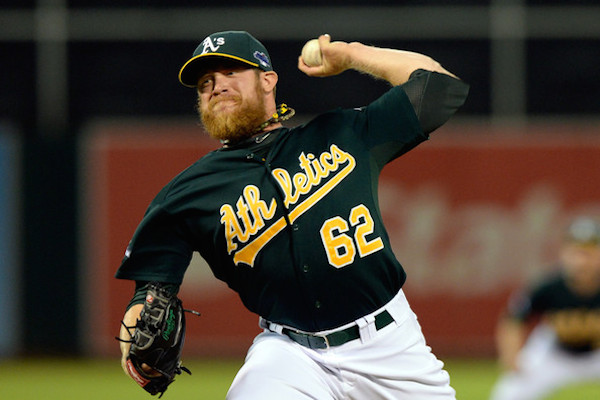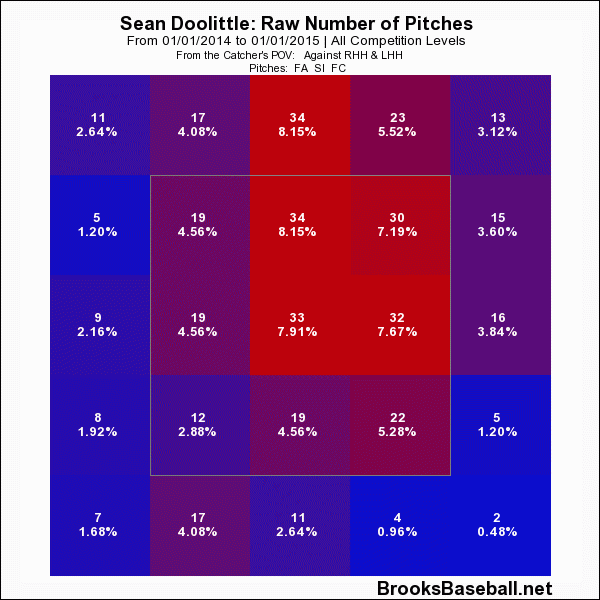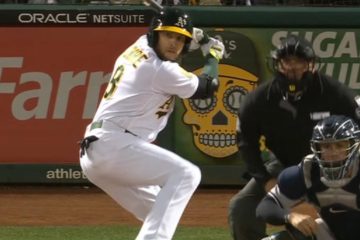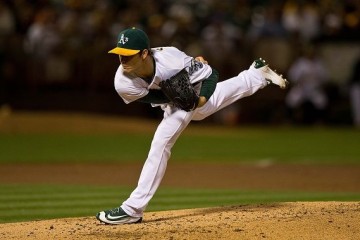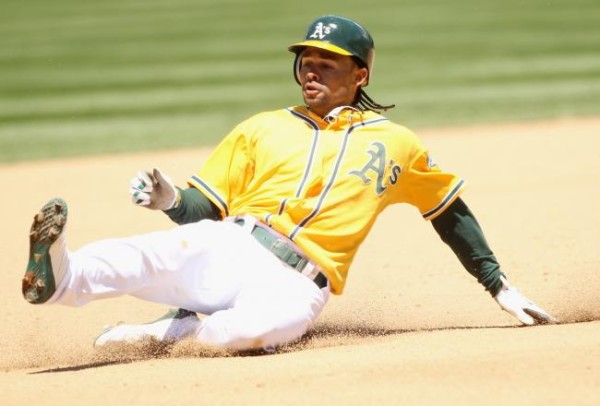2014 Fantasy Baseball: Sean Doolittle’s Historic Campaign
For the most part, fantasy players don’t pay for saves anymore. Nearly every guide during draft season contains advice about not spending much of your budget on closers. As we know, closers are fickle. They fall out of favor with managers and quickly lose their jobs. Hell, we’re lucky if half of the teams don’t replace their closer with a more talented pitcher at some point during the season. Case in point: Sean Doolittle.
Jim Johnson was acquired in the offseason by the Athletics. He was supposed to be their “closer”; they’re paying him $10 million, after all. Things didn’t work out. Johnson hasn’t been very good. Maybe he hasn’t bad as bad as his ERA shows, but he hasn’t pitched well, nonetheless. The Athletics were forced to make a change. Luckily for them, they had one of the best relievers in the major leagues already in their fold.
[am4show have=’p11;p7;’ guest_error=’Front Office’ user_error=’Front Office’ ]
Since his debut in 2012, Doolittle has a 2.89 ERA. A number that is backed up by a 2.17 FIP and 3.11 xFIP. He’s struck out 28.7% [10 K/9] of the batters he’s faced while only walking 4.3% [1.51 BB/9] of them. He’s been fantastic in every aspect of the game, destroying all hitters, even righties. In his career, right handed batters – who, in theory, have a platoon advantage – have a wOBA of .243; lefties have a .246 mark. Doolittle is indiscriminate on the mound.
This piece, however, isn’t about Doolittle’s career. It’s about his success this season. At age 27, he’s thriving. In 33 innings, he has issued 1 (!) free pass, or, if you prefer percentages, he’s walked 0.8% of the batters he’s faced. That’s not a typo. He’s walked one batter out of the 121 he’s faced, while striking out 46 [38%]. For some context, here are the best relief season since 1990, sorted by K-BB% – a stat that’s similar to K/BB, but a little better, in my opinion.
| Season | Name | Team | K-BB% | HR/9 | WHIP | BABIP | LOB% | ERA- | FIP- | xFIP- |
|---|---|---|---|---|---|---|---|---|---|---|
| 2012 | Craig Kimbrel | Braves | 44.20% | 0.43 | 0.65 | 0.250 | 92.80% | 26 | 21 | 23 |
| 2014 | Dellin Betances | Yankees | 38.70% | 0.22 | 0.71 | 0.257 | 80.40% | 38 | 24 | 31 |
| 2003 | Eric Gagne | Dodgers | 38.20% | 0.22 | 0.69 | 0.243 | 83.90% | 30 | 20 | 26 |
| 2014 | Sean Doolittle | Athletics | 37.20% | 0.55 | 0.64 | 0.250 | 71.40% | 57 | 33 | 53 |
| 2012 | Aroldis Chapman | Reds | 35.90% | 0.50 | 0.81 | 0.252 | 86.90% | 38 | 40 | 50 |
| 1999 | Billy Wagner | Astros | 35.30% | 0.60 | 0.78 | 0.226 | 86.50% | 36 | 37 | N/A |
| 2014 | Craig Kimbrel | Braves | 34.80% | 0.00 | 0.95 | 0.306 | 71.40% | 54 | 21 | 42 |
| 2013 | Koji Uehara | Red Sox | 34.70% | 0.61 | 0.57 | 0.188 | 91.70% | 26 | 39 | 53 |
| 2014 | David Robertson | Yankees | 34.70% | 1.14 | 1.14 | 0.349 | 74.60% | 84 | 57 | 35 |
| 2004 | Brad Lidge | Astros | 34.40% | 0.76 | 0.92 | 0.292 | 88.00% | 44 | 43 | 46 |
First things first, the results are undoubtedly a little skewed towards currently active relievers due to increasing strikeout rates across the game. Caveats aside, Doolittle is in rarified air. He’s near the top of Mt. Everest. He’s breathing in the air that has been reserved for the best of the best: Craig Kimbrel, Aroldis Chapman, Billy Wagner, prime Eric Gagne, and prime Brad Lidge. [Sidebars: Jesus, Dellin Betances has been awesome, too. And Chapman’s 2014 is currently better than Kimbrel’s 2012. He just didn’t show up, because he has met the innings requirement to be a “qualified pitcher” yet.]
You could make the case Doolittle’s been a little unlucky this season, as far as stranding runners is concerned. Other than that, it’s remarkable how similar all of the seasons above have been. Only one pitcher above – David Robertson – has seen his FIP- be larger than 43. Even then, Robertson’s FIP- means that his FIP – after adjusted for park, league, etc. – was still 43% lower than the rest of the league. And according to FIP-, Doolittle is having the fifth best season for any qualified reliever has had since 1990. It’s a remarkable feat. And he has been able to post his gaudy numbers thanks mostly to velocity and command.
So far, Doolittle has thrown 469 pitches; 396 of them have been classified as fastballs, according to Fangraphs. On average, those fastballs have registered 94 mph. So, when batters are facing Doolittle, 84.4% – the highest rate of fastballs among relievers – of the time they’re getting borderline elite velocity pumped at them, knowing, more than likely the pitch is going to be a strike. Yet, they’re still unable to do anything with the pitch.
There’s an old saying in baseball, “professional hitters could time a jet, if they saw it enough.” Well, professional hitters have seen Doolittle’s fastball a ton; they still haven’t mastered it, due to multiple factors. Two of those factors are: deception and location. Eno Sarris wrote about the deception in Doolittle’s motion in April 2013, including some quotes from Doolittle himself:
But Doolittle thinks there’s more to this than just break and velocity. “I throw three quarters and I’m so far up the first base side of the rubber that it comes in on a diagonal, and that’s why it’s such an effective pitch against righties” Doolittle said to me. And the lefty has a reverse platoon split indeed. It’s a small sample, but he strikes out seven percent more right-handed batters than lefties.
How far out is the former firstbaseman’s placement on the first base side? Sorta. He has the 34th-most extreme “x” value on his release. Right between Sean Marshall, Charlie Furbush and Randy Wolf, there’s Doolittle.
If you follow the list all the way to the very extreme — another half foot or so — you do get some interesting names: Jake Diekman, Joe Thatcher, Sean Burnett,Javier Lopez and Clay Rapada are the top five. As a group, these lefties have a career FIP around three against lefties, and close to five against righties. They aren’t all strictly LOOGYs, but they have LOOGY tendencies.
…
And of course there’s more to it. “I try to do a good job of hiding the ball with my front side — it kind of comes out of a weird spot with my high front side and where I throw, my release point is kind of by my ear,” said Doolittle, adding that “deception is kind of why I get away” with throwing one pitch so often. That’s a bit hard to test, but we can take a look:
It’s not the greatest GIF, but it gives you a sense of where Doolittle sets up on the rubber, his high front side (watch the glove), and a little bit of the release point by the ear.
Interesting, right? There is also one other thing that is interesting, perhaps even more interesting after reading this – seriously, if you enjoy pitching, read that. Doolittle throws his fastball up in the zone quite a bit.
Against right handed batters, he pitches middle-away, but more often than not the pitch is middle-up. Same for lefties so far this year, except he’s really been middle-up only with the fastball versus them [small sample size, obviously]. And as you would expect, he gets more whiffs on his fastball when it’s up.
Doolittle’s 2014 success didn’t come out of nowhere. He’s been good for quite some time, although, not this good. He’s probably going to stay good for a little while; weird things happen to relievers, though, so enjoy him while you can. In the process of breaking out, Doolittle has shown us once again, that stuff matters more than roles do.
ESPN’s player rater has the following names in the top 30 for relievers – they would rank higher if not starters with double eligibility: Joakim Soria, Dellin Betances, Zach Britton, Doolittle, Jean Machi, Mark Melancon, Wade Davis, Tony Watson, Jake McGee, and Pat Neshek. None of those men were their team’s “closer” when the season began. Neshek, Davis, Betances, Machi, Watson, and Melancon still aren’t, although Melancon closed for a little bit while Jason Grilli was injured. Despite that, they’re valuable thanks to their ratios, strikeouts, and run prevention.
In fantasy, we’re forced to chase saves – unless you do a saves+holds league, which I recommend – but perhaps we shouldn’t chase them as much. Chances are you could have drafted: Doolittle, Davis, and Jake McGee at the very end of your draft, or paid very little for them, collectively, in an auction. That’s much better than paying retail for: Addison Reed, Grant Balfour, and Grilli. And even if the first group wouldn’t have panned out, so what? You haven’t lost anything. Using precious auction dollars, or mid-draft picks on Balfour or Reed, though? That’ll cost you something.
Note: All the numbers above are as of Tuesday, June 17. Since then, Doolittle has made one appearance, striking out two batters and walking none, pushing his K-BB% up to 37.90% and his FIP down to 1.18.
[/am4show]


